How to make a biofireplace with your own hands: device, diagrams and step-by-step assembly instructions
The contemplation of living fire is mesmerizing. A well-known proverb states that you can do this endlessly.The dance of the flame calms and pacifies, helps to collect thoughts. Unfortunately, such luxury is practically unavailable to those living in apartment buildings.
Setting up a wood-burning fireplace is not affordable for everyone. A good solution is to assemble a biofireplace with your own hands, while saving on the purchase of a ready-made structure. If you have never done this kind of work, our article will be a good help - here we looked at the structure and operating principle of a biofireplace, the main types of design, which will help you decide on the optimal scheme for assembling a homemade product.
They also provided detailed instructions for making a fireplace with your own hands, illustrating it with step-by-step photos and supplementing it with useful video recommendations. Thanks to a step-by-step analysis of each stage, even a novice master can assemble a biofireplace.
The content of the article:
What is a biofireplace?
The biofireplace, which is becoming fashionable, is a decorative source of open fire that runs on so-called biofuel. For safe operation, the device is framed by a portal that traps the flame inside.
Structurally, a biofireplace is a burner that runs on alcohol fuel. A mandatory element of the device is a fuel tank, which contains a sufficient supply of flammable liquid for operation.
A wick is inserted into the tank, along the fibers of which the fuel rises to the place of combustion.The combustion itself takes place in a special bowl, which can have a variety of shapes. The sizes of biofireplaces vary significantly.

To extinguish the flame, just cover the burner with a special damper. It will block the access of oxygen, without which the combustion process is impossible. A damper must be available for each device. The device may have several burners.
In addition, some burners are equipped with nozzles. This makes the flames as similar as possible to those formed when burning wood in a fire or fireplace.
The devices are very convenient to use. First of all, they don't need a chimney. During combustion, biofuels are oxidized to carbon dioxide and water vapor. The absence of heavy impurities in the flammable liquid allows it to burn completely, without the formation of soot, soot and volatile toxic substances.
Therefore, smoke removal (which does not form) is not required. Thanks to this, the biofireplace can be installed anywhere in the room.
It does not need a heat-resistant floor frame or a separate foundation. Special permission for its installation is also not required. The only thing you need to consider when choosing a place to install a biofireplace is the possibility of ventilating the room or the presence effective ventilation. This is necessary because combustion uses oxygen, the amount of which must be constantly replenished.
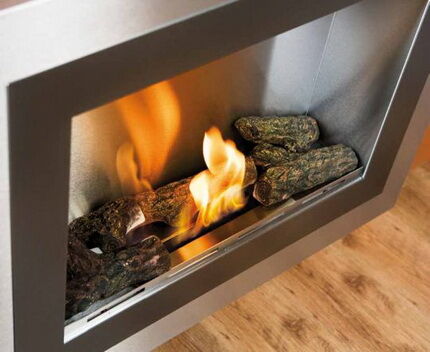
Biofireplaces are not only decorative, but also functional. Unlike traditional fireplaces, where most of the heat “goes” into the chimney, the devices completely transfer their heat into the room. Of course, you won’t be able to use such a device as a heating device, but it will be able to heat some area in the room. Biofireplaces are completely safe if used correctly.
The industry produces models that are most comfortable to use, equipped with electronic controls. They can be controlled from a remote control or via Wi-Fi. In the latter case, it is quite possible to integrate the device into the Smart Home system and remotely control it from a phone or tablet. It is clear that the cost of automatic biofireplaces is an order of magnitude higher than that of conventional ones.
At the same time, standard models can be considered “eternal”, since they are structurally extremely simple and there is nothing to break in them, while devices stuffed with electronics may well fail.
The main disadvantage of biofireplaces is their high cost. The operation of the devices will also be quite expensive, since they only require special fuel to operate. It will not be possible to replace it with a cheap analogue.
Composition and features of biofuel
The “bio” part of the word “biofuel” explains that only natural, renewable raw materials are used to produce this substance. Therefore, it is completely environmentally friendly and biodegradable.
The main components used to produce such fuel are grasses and grains containing large amounts of starch and sugar. Thus, corn and cane are considered the best raw materials.
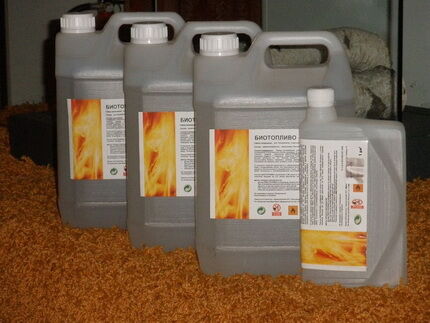
They produce bioethanol, or a type of alcohol. It is a colorless liquid and has no odor. If necessary, it can replace gasoline, however, the cost of such a substitute is much higher. When burned, pure bioethanol decomposes into water in the form of vapor and carbon dioxide.
In this way, it is even possible to humidify the air in the room where the bio-fireplace is installed. The substance burns with the formation of a blue “gas” flame.
This is a purely aesthetic drawback that prevents you from still enjoying the sight of an open fire. A traditional fireplace produces a yellow-orange flame, which is a kind of standard. To eliminate this drawback, additives are introduced into biofuels that change the color of the flame.
Thus, the traditional composition of a flammable liquid is as follows:
- bioethanol – about 95%;
- methyl ethyl ketone, denaturing substance - about 1%;
- distilled water - about 4%.
In addition, crystalline bitrex is added to the fuel composition. This powder has an extremely bitter taste and is intended to prevent alcohol biofuels from being consumed as alcohol. Biofuel is produced in different brands, its composition may vary somewhat, but in general does not change. It is clear that the cost of such fuel is quite high.

Fuel consumption depends on the number of burners and the power of the biofireplace. On average, a 2-3 hour operation of a heating unit with a power of about 4 kW per hour consumes about a liter of flammable liquid. In general, operating a biofireplace turns out to be quite expensive, so home craftsmen are trying to find a cheaper alternative to fuel. There is such an option and it is viable.
To avoid trouble, you need to purchase only high-quality components for homemade fuel. We must not forget that the bio-fireplace does not have a smoke exhaust, and all combustion products immediately enter directly into the room.
If toxic substances are present in the fuel, and this is not uncommon for low-quality alcohol-containing compounds, they will end up in the room. This threatens with the most unpleasant consequences. We recommend that you read the best biofuel brands.
Therefore, it is not recommended to make fuel for a biofireplace yourself. However, if you really want to experiment, this is the safest recipe. Take pure medical alcohol. It must be purchased at a pharmacy.
To color the flame, highly purified gasoline is added to it, which is used to refill lighters (“Galoshes”).
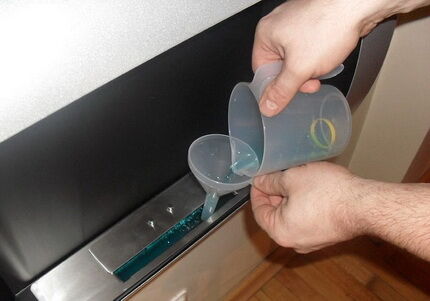
Liquids are measured and mixed.Alcohol should be present in a volume of 90 to 94% of the total amount of fuel, gasoline can account for 6 to 10%. The optimal proportion is determined empirically, but you should not go beyond the recommended values. Detailed instructions for the production and use of biofuel is given here.
It is important to remember that the resulting fuel cannot be stored, since the mixture of gasoline and alcohol will separate. It should be prepared before use and shaken well for better mixing.
What types of biofireplaces are there?
Biofireplaces are available in a variety of options. Depending on the installation location, there are four main types of devices.
Type #1 - wall-mounted devices
Such bio-fireplaces are a flat, elongated structure that is mounted on the wall. The front part of the device is covered with transparent glass for safety reasons. The side walls are decorated in the same way. The back wall is made of fireproof material (usually metal) and decorated.
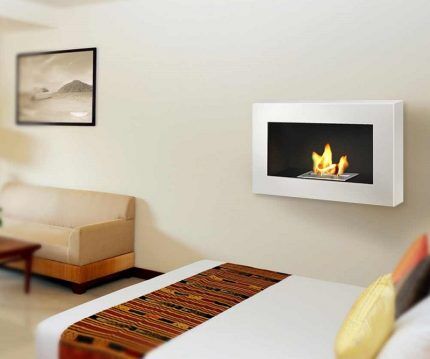
The design is easy to install. It is hung on fasteners installed in the wall. The device is completely safe to use, since during the combustion process the back wall and bottom of the housing heat up slightly. They cannot cause a fire or cause a burn to a person who accidentally touches them.
Type #2 - floor biofireplaces
The structure is installed on the floor or a small podium. Its bottom does not heat up much, so you can place such a device on any suitable flat surface. The shape and size can be very different.
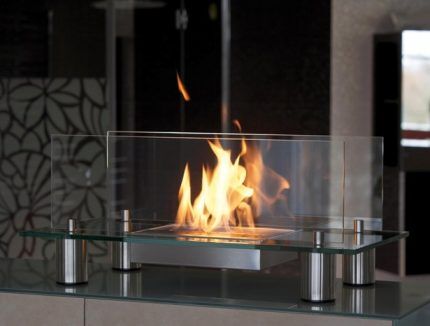
The main advantage of the device is mobility. If desired, it can be easily moved to another place. Using floor-standing appliances, you can heat part of the room for a short time.
View #3 - desktop devices
They are compact varieties of floor-standing models. They are placed on shelves, tables or special stands, so they are small in size.
It may be difficult to consider them full-fledged fireplaces, since they are quite compact, but the devices are mobile. They are easy to carry from place to place. They are functional and very easy to use.
Type #4 - built-in structures
Built-in biofireplaces look very organic. Such devices are mounted in a niche in the wall specially prepared for this purpose. There are devices whose front wall looks like a continuation of the wall. They are viewable from only one side.

Bio-fireplaces called “lanterns” are produced. They have a convex or multifaceted front wall. Such devices “protrude” slightly from the wall, which makes them very unusual and attractive. Installing a built-in biofireplace is much more difficult than a wall-mounted one.
You need to choose a place for it very carefully; moving the device will be very troublesome and time-consuming.
We have another article on our website that discusses in more detail types of biofuel fireplaces and the principle of their action.
Instructions for making a compact model
Considering that the cost of such devices is quite high, many craftsmen are interested in how to make a bio-fireplace for a room on their own.
This is a fairly simple task, especially if you make a compact tabletop or floor-standing model. It can be roughly divided into two components: the fuel tank and the glass body. As a second one, you can use an old aquarium without a bottom.
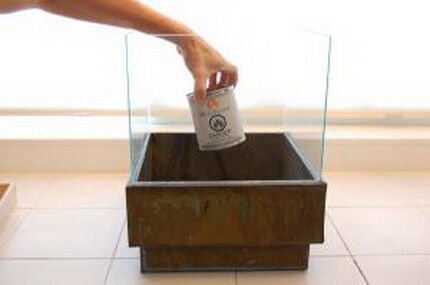
For work we will need the following materials:
- a metal box that will be used as a base;
- metal reservoir for fuel tank;
- wick cord;
- a sheet of glass if there is no aquarium;
- silicone sealant;
- metal grid;
- small pebbles.
The tools you need to prepare are a glass cutter and scissors.
Let's get to work and start with the body. It will be a parallelepiped or cube without a lid or bottom. We determine the dimensions of the future structure and, accordingly, the length and width of its walls. Place the glass sheet on a flat horizontal surface, wash and degrease.
We apply a ruler to the line of the future cut and press it against the sheet. To prevent the ruler from slipping, you can stick an adhesive plaster on it.
We take a diamond glass cutter, place it on the sheet and move it away from us without strong pressure. The cutting line should be colorless and thin. If for some reason we don’t like the resulting line, we absolutely cannot circle it. You should retreat 1 mm and draw a new line.Having completed the cut, we move the glass to the edge of the base so that it coincides with the cutting line.
We carefully tap the cutting line with the head of the tool, then with a careful but precise movement we break off the glass that remains suspended. In this way we cut out all four parts of the required size.
Now they need to be glued together with silicone sealant. To do this, generously coat the side edges of the parts and connect them. Let the sealant dry. To do this, we fix the resulting structure between any fixed objects and leave it in this position for a day.
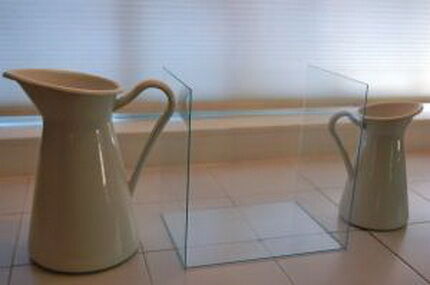
The dried body is cleaned of excess sealant. It will be convenient to do this with a blade. Let's start making the base of the bio-fireplace. It should be a metal box that matches the size of the glass case.
The latter should be easily and securely installed on a metal base. A metal can should also be installed inside the base, which will act as a fuel tank.
It is desirable that the volume of the tank is large enough so that you do not have to refill the bio-fireplace too often. The can is installed in the center of the structure. A part is cut out of a durable metal mesh, the size of which coincides with the base. It is placed on top of the fuel tank and secured to the edges of the base.
We make a wick from the prepared cord and lower it into a tank with fuel. Kinds homemade burners for biofireplaces and instructions for their manufacture are discussed in our other article.
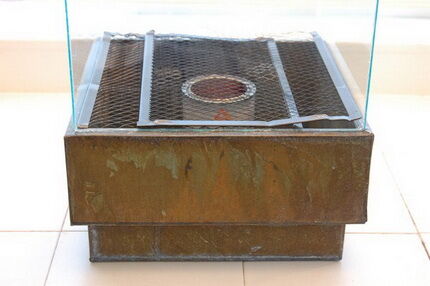
We place pebbles or any other stones on top of the mesh so that they completely cover it. The stones will serve not only a decorative function. They will partially remove the heat that will be transferred from the burner to the metal mesh.
This way you can protect the glass from cracking. Now you can put the glass case in place. The compact bio-fireplace is ready for use.
Instructions for assembling a large bio-fireplace
If you need to make a large bio-fireplace, the most difficult part will be making the fuel tank. The easiest way is to purchase a ready-made element in a specialized store.
If you plan to make the tank yourself, you need to take a sheet of metal more than 3 mm thick. It must be stainless steel, otherwise during combustion there may be unwanted chemical reactions and even the appearance of toxic fumes.
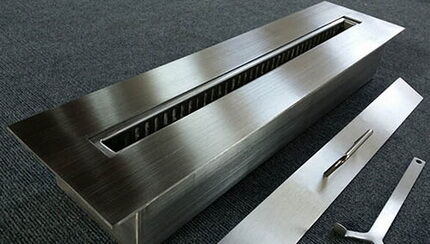
The tank itself should consist of two compartments. The lower one is for filling fuel. Vapors of flammable liquid burn in the upper compartment. Between these compartments there should be a separating plate with holes, thanks to which vapors enter the combustion zone. The shape of the tank may be different, depending on the fireplace model.
The most popular option is a parallelepiped-shaped fuel tank with a narrow upper compartment.
It is easier to make a cylindrical tank.To do this, you can take an ordinary mug and cover it with a lid cut to size from a fine-mesh metal mesh. Fuel can be poured through the mesh, which is quite convenient.

Having decided on the fuel tank, you can start making a bio-fireplace. Let's make a floor model with two glass screens. To work, you need to prepare fire-resistant glass for screens, a fuel tank in the shape of a parallelepiped, washers, bolts and silicone gaskets for glass, plastic or metal legs.
In addition, to make the base we will need thick plywood or plasterboard, screws and 40x30 mm wood blocks.
Let's start from the foundation. We mark a sheet of plywood and carefully cut out the side parts of the base box and the top panel from it. We will not make the lower part of the box.
Firstly, its presence will significantly make the structure heavier. Secondly, it will be much more convenient to secure glass sheets without it. We are preparing two pieces of wooden block onto which the plywood will be attached.
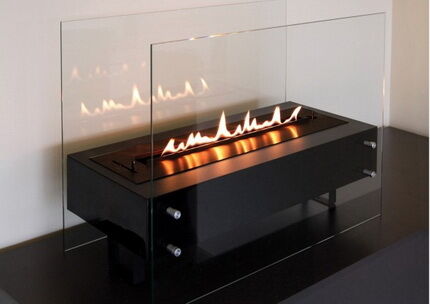
On a panel cut from plywood we mark the place where the fuel tank will be fixed. Cut out the required mounting hole for the tank. Now we assemble the frame and attach the top panel to it. We process the edges of the structure well.
If we used drywall rather than plywood, its edges must be treated with putty.We decorate the resulting base in any suitable way: paint, varnish, etc.
Preparing glass panels. First, cut out two parts of the desired size. In each of them you need to drill holes for decorative fasteners. This is quite difficult, because the slightest mistake can cause the glass to crack. If you have no experience in such work, it is better to entrust the process to an experienced craftsman with a set of special tools. Holes for fasteners are also drilled on the side walls of the base.
Now we fix the glass screen to the base. To do this, we pass a bolt through the glass, do not forget to put on a silicone gasket so as not to damage the glass. We pass the bolt through the base, put on the washer and tighten the nut. This must be done extremely carefully, without applying excessive force, otherwise the glass may crack. In this way we install both glass screens.
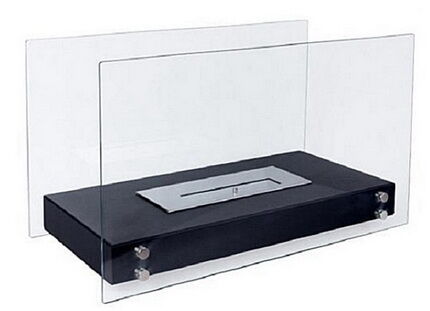
You need to place legs on the bottom of the glass sheet. To do this, we put rubber gaskets into the parts and put them in place. We check the correct installation of the legs. The biofireplace should stand level and not wobble.
Using the prepared hole, we mount the fuel tank and securely fasten it. The structure is almost ready. All that remains is to decorate it with stones or ceramic logs, if necessary.
Conclusions and useful video on the topic
Making a miniature tabletop biofireplace:
Automatic bio-fireplace - what is it:
Biofireplace manufacturing process:
A biofireplace will give your home a special atmosphere.To enjoy the dance of living fire at any time, it is enough to assemble a simple structure.
It is important not to forget about the safety rules: do not use fuel of unknown origin, do not leave the fire unattended, do not pour fuel into a device that has not cooled down, and do not forget to regularly ventilate the room in which the bio-fireplace is operating..
Have you completed your interior with a bio-fireplace made by yourself? Do you have any additions or useful assembly tips? Or have you noticed any inaccuracies in the material we offer? Write to us about this, share photos of your homemade product - your experience will inspire the creativity of other users.





Wow, it still never occurred to me that you could make a bio-fireplace yourself. To be honest, I didn’t even try to understand its structure. But it’s nothing complicated, as it turns out, just elementary physics. The main thing is that it is safe for health and does not require compliance with any special safety regulations. I'll try to do it in the near future, especially since I have an aquarium.
I think this would be a great idea, especially if you live in a private home. If you know how to cook, that's even better. You can give free rein to your imagination and assemble a truly worthwhile and original bio fireplace with your own hands. I'm glad that it is safe, but some rules still need to be followed. But the question is: does it generate heat or is it just for show?
A bit of a strange question. It seems like the answer to both is “yes.” Naturally, a biofireplace produces heat. And the amount of this heat depends solely on the size of the fireplace itself.However, in any case, it will not be enough to heat an apartment or room from scratch. The place where it is installed will be warmer than at the other end of the room, but no more. Still, this is more about aesthetics than an alternative to devices specifically designed for heating.
I think that you can use not only sheet glass, but also finished products - there are glass containers made from laboratory glass, glass pipes, and some kind of glass protective casings.
Hello. Could you tell me if it is possible to use something else instead of ceramic filler and honeycomb filler? Tell me, what can you notice? Thank you.